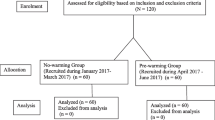Abstract
Purpose
The purpose of our study was to determine the effects of anesthetic technique and ambient temperature on thermoregulation for patients undergoing lower extremity surgery.
Methods
Our study included 90 male patients aged 18–60 years in American Society of Anesthesiologists Physical Status groups I or II who were scheduled for lower extremity surgery. Patients were randomly divided into three groups according to anesthetic technique: general anesthesia (GA), epidural anesthesia (EA), and femoral-sciatic block (FS). These groups were divided into subgroups according to room temperature: the temperature for group I was 20–22 °C and that for group II was 23–25 °C. Therefore, we labeled the groups as follows: GA I, GA II, EA I, EA II, FS I, and FS II. Probes for measuring tympanic membrane and peripheral temperature were placed in and on the patients, and mean skin temperature (MST) and mean body temperature (MBT) were assessed. Postoperative shivering scores were recorded.
Results
During anesthesia, tympanic temperature and MBT decreased whereas MST increased for all patients. There was no significant difference between tympanic temperatures in either the room temperature or anesthetic method groups. MST was lower in group GA I than in group GA II after 5, 10, 15, 20, 60 and 90 min whereas MBT was significantly lower at the basal level (p < 0.05). MST after 5 min was significantly lower in group GA I than in group FS I (p < 0.05). Shivering score was significantly higher in group GA I (p < 0.05).
Conclusions
There were no significant differences in thermoregulation among anesthetic techniques. Room temperature affected thermoregulation in Group GA.






Similar content being viewed by others
References
Sessler D. Temperature monitoring. In: Miller RD, editor. Miller’s anesthesia. Philadelphia: Elsevier Churchill Livingstone; 2010. p. 1367–89.
Sessler DI, McGuire J, Moayeri A, Hynson J. Isoflurane-induced vasodilation minimally increases cutaneous heat loss. Anesthesiology. 1991;74:226–32.
Sessler DI, McGuired J, Hynson J, Moayeri A, Heier P. Thermo-regulatory vasoconstriction during isoflurane anesthesia minimally decreases cutaneous heat loss. Anesthesiology. 1992;76:670–5.
Shanks CA. Mean skin temperature during anaesthesia: an assessment of formulae in the supine surgical patient. Br J Anaesth. 1975;47(8):871–6.
Greenberg SB, Murphy GS, Vender JS. Standard monitoring techniques. In: Barash PG, Cullen BF, Stoelting RK, Cahalan MK, Stock MC, editors. Clinical anesthesia. Philadelphia: Lippincott Williams Wilkins; 2009. p. 697–714.
Tander B, Baris S, Karakaya D, Ariturk E, Rizalar R, Bernay F. Risk factors influencing inadvertent hypothermia in infants and neonates during anesthesia. Pediatr Anesth. 2005;15:574–9.
Frank SM, Beattie C, Christophers R. Epidural versus general anesthesia, ambient operating room temperature and patient age as predictors of inavedverted hypothermia. Anesthesiology. 1992;77:252–7.
Yentur EA, Topcu I, Ekici Z, Ozturk T, Keles GT, Civi M. The effect of epidural and general anesthesia on newborn rectal temperature at elective cesarean section. Braz J Med Biol Res. 2009;42:863–7.
Jenkins J, Fox J, Sharwood-Smith G. Changes in body heat during transvesical prostatectomy. A comparison of general and epidural anaesthesia. Anaesthesia. 1983;38:748–53.
Frank SM, Shir Y, Raja SN, Fleisher LA, Beattie C. Core hypothermia and skin-surface temperature gradients: epidural versus general anesthesia and the effects of age. Anesthesiology. 1994;80:502–8.
Frank SM, El-Rahmany HK, Cattaneo CG, Barnes R. Predictors of hypothermia during spinal anesthesia. Anesthesiology. 2000;92:1330–4.
Johnson JM, Proppe DW. Cardiovascular adjustments to heat stress. In: Fregly MJ, Blatteis CM, editors. Handbook of physiology. New York: Oxford University Press; 1996. p. 215–43.
Stevens MF, Werdehausen R, Hermanns H, Lipfert P. Skin temperature during regional anesthesia of the lower extremity. Anesth Analg. 2006;102:1247–51.
Crossley AW. Peri-operative shivering. Anaesthesia. 1992;47:193–5.
Bugy DJ, Crossley AWA. Thermoregulation, mild perioperative hypothermia and postanaesthetic shivering. Br J Anaesth. 2000;84:615–28.
Sessler DI, Rubinstein EH, Moyari A. Phyiologic responses to mild perianesthetic hypothermia in humans. Anesthesiology. 1991;75:594–610.
Wrench IJ, Singh P, Dennis AR, Mahajan RP, Crossley AW. The minimum effective doses of pethidine and doxapram in the treatment of post-anaesthetic shivering. Anaesthesia. 1997;52:32–6.
Leslie K, Sessler DI. Reduction in the shivering threshold is proportional to spinal block height. Anesthesiology. 1996;84:1327–31.
Vassilieff N, Rosencber N, Sessler DI, Conseiller C. Shivering threshold during spinal anesthesia is reduced in elderly patients. Anesthesiology. 1995;83:1162–6.
Annadata R, Sessler DI, Tayefeh F, Kurz A, Dechert M. Desflurane slightly increases the sweating threshold but produces marked, nonlinear decreases in the vasoconstriction and shivering thresholds. Anesthesiology. 1995;83:1205–11.
Lenhardt R, Greif R, Sessler DI, Laciny S, Rajek A, Bastanmehr H. Relative contribution of skin and core temperatures to vasoconstriction and shivering thresholds during isoflurane anesthesia. Anesthesiology. 1999;91:422–9.
Catro-Alves LJ, De Azevedo VL, De Freitas Braga TF, Goncalves AC, De Oliveira GS Jr. The effect of neuraxial versus general anesthesia techniques on postoperative quality of recovery and analgesia after abdominal hysterectomy: a prospective, randomized, controlled trial. Anesth Analg. 2011;113:1480–6.
Attari MA, Mirhosseini SA, Honarmand A, Safavi MR. Spinal anesthesia versus general anesthesia for elective lumbar spine surgery: a randomized clinical trial. J Res Med Sci. 2011;16:524–9.
Author information
Authors and Affiliations
Corresponding author
About this article
Cite this article
Ozer, A.B., Tosun, F., Demirel, I. et al. The effects of anesthetic technique and ambient temperature on thermoregulation in lower extremity surgery. J Anesth 27, 528–534 (2013). https://doi.org/10.1007/s00540-013-1555-2
Received:
Accepted:
Published:
Issue Date:
DOI: https://doi.org/10.1007/s00540-013-1555-2




